2016 NISSAN 370Z COUPE air condition
[x] Cancel search: air conditionPage 367 of 428

8-18Maintenance and do-it-yourself
SDI2119VQ37VHR engine1. Power steering fluid pump
2. Alternator
3. Crankshaft pulley
4. Air conditioner compressor
5. Drive belt auto-tensioner
WARNING
Be sure the ignition switch is in the OFF
or LOCK position before servicing drive
belts. The engine could rotate unex-
pectedly.1. Visually inspect the belt for signs of unusual
wear, cuts, fraying or looseness. If the belt is
in poor condition or loose, have it replaced
or adjusted by a NISSAN dealer.
2. Have the belt condition checked regularly.
WARNING
Be sure the engine and the ignition
switch are off and that the parking
brake is engaged securely.
CAUTION
Be sure to use the correct socket to
remove the spark plugs. An incorrect
socket can damage the spark plugs.
DRIVE BELTS SPARK PLUGS
Page 371 of 428
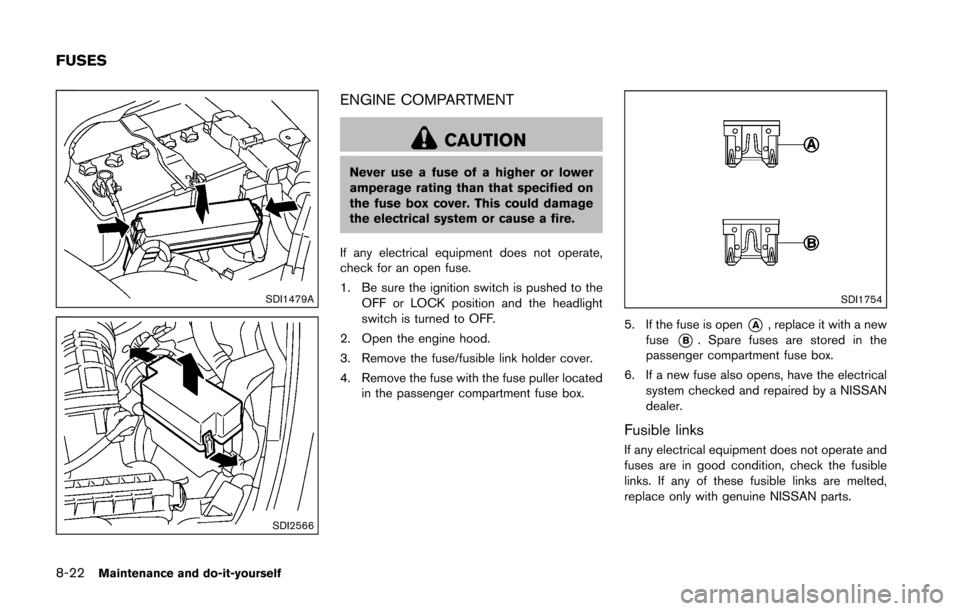
8-22Maintenance and do-it-yourself
SDI1479A
SDI2566
ENGINE COMPARTMENT
CAUTION
Never use a fuse of a higher or lower
amperage rating than that specified on
the fuse box cover. This could damage
the electrical system or cause a fire.
If any electrical equipment does not operate,
check for an open fuse.
1. Be sure the ignition switch is pushed to the OFF or LOCK position and the headlight
switch is turned to OFF.
2. Open the engine hood.
3. Remove the fuse/fusible link holder cover.
4. Remove the fuse with the fuse puller located in the passenger compartment fuse box.
SDI1754
5. If the fuse is open*A, replace it with a new
fuse
*B. Spare fuses are stored in the
passenger compartment fuse box.
6. If a new fuse also opens, have the electrical system checked and repaired by a NISSAN
dealer.
Fusible links
If any electrical equipment does not operate and
fuses are in good condition, check the fusible
links. If any of these fusible links are melted,
replace only with genuine NISSAN parts.
FUSES
Page 379 of 428
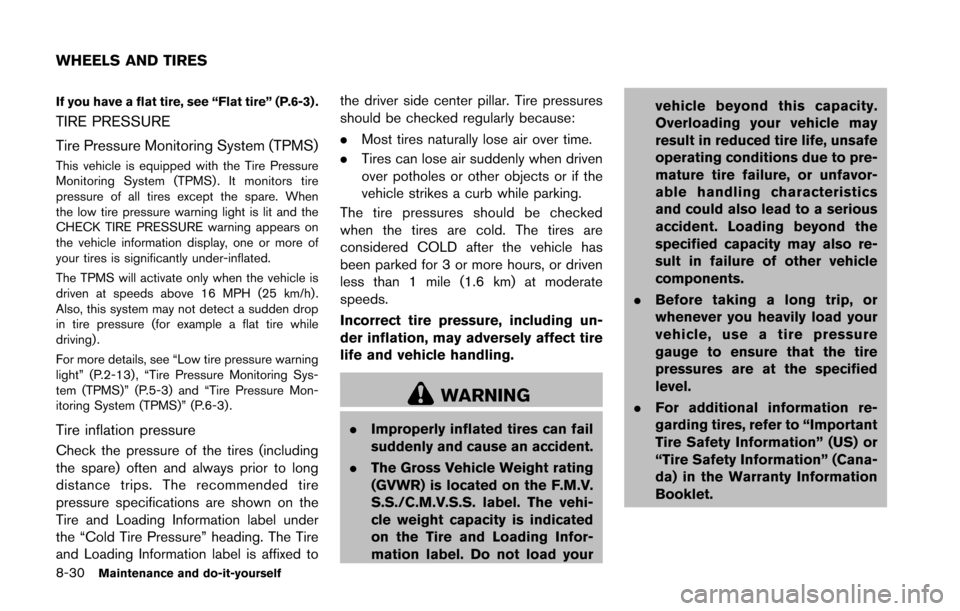
8-30Maintenance and do-it-yourself
If you have a flat tire, see “Flat tire” (P.6-3) .
TIRE PRESSURE
Tire Pressure Monitoring System (TPMS)
This vehicle is equipped with the Tire Pressure
Monitoring System (TPMS) . It monitors tire
pressure of all tires except the spare. When
the low tire pressure warning light is lit and the
CHECK TIRE PRESSURE warning appears on
the vehicle information display, one or more of
your tires is significantly under-inflated.
The TPMS will activate only when the vehicle is
driven at speeds above 16 MPH (25 km/h) .
Also, this system may not detect a sudden drop
in tire pressure (for example a flat tire while
driving) .
For more details, see “Low tire pressure warning
light” (P.2-13) , “Tire Pressure Monitoring Sys-
tem (TPMS)” (P.5-3) and “Tire Pressure Mon-
itoring System (TPMS)” (P.6-3) .
Tire inflation pressure
Check the pressure of the tires (including
the spare) often and always prior to long
distance trips. The recommended tire
pressure specifications are shown on the
Tire and Loading Information label under
the “Cold Tire Pressure” heading. The Tire
and Loading Information label is affixed tothe driver side center pillar. Tire pressures
should be checked regularly because:
.
Most tires naturally lose air over time.
. Tires can lose air suddenly when driven
over potholes or other objects or if the
vehicle strikes a curb while parking.
The tire pressures should be checked
when the tires are cold. The tires are
considered COLD after the vehicle has
been parked for 3 or more hours, or driven
less than 1 mile (1.6 km) at moderate
speeds.
Incorrect tire pressure, including un-
der inflation, may adversely affect tire
life and vehicle handling.
WARNING
. Improperly inflated tires can fail
suddenly and cause an accident.
. The Gross Vehicle Weight rating
(GVWR) is located on the F.M.V.
S.S./C.M.V.S.S. label. The vehi-
cle weight capacity is indicated
on the Tire and Loading Infor-
mation label. Do not load your vehicle beyond this capacity.
Overloading your vehicle may
result in reduced tire life, unsafe
operating conditions due to pre-
mature tire failure, or unfavor-
able handling characteristics
and could also lead to a serious
accident. Loading beyond the
specified capacity may also re-
sult in failure of other vehicle
components.
. Before taking a long trip, or
whenever you heavily load your
vehicle, use a tire pressure
gauge to ensure that the tire
pressures are at the specified
level.
. For additional information re-
garding tires, refer to “Important
Tire Safety Information” (US) or
“Tire Safety Information” (Cana-
da) in the Warranty Information
Booklet.
WHEELS AND TIRES
Page 387 of 428
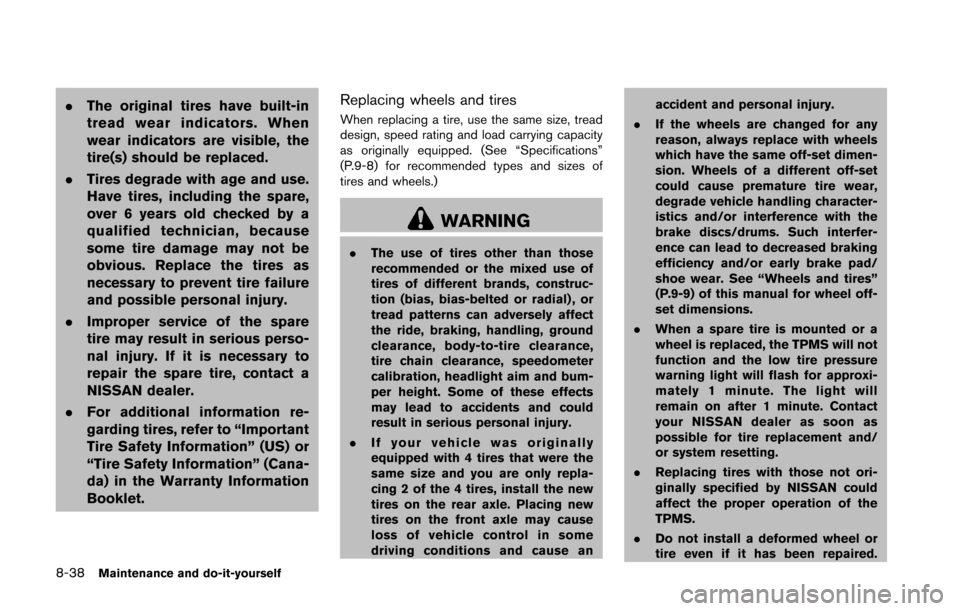
8-38Maintenance and do-it-yourself
.The original tires have built-in
tread wear indicators. When
wear indicators are visible, the
tire(s) should be replaced.
. Tires degrade with age and use.
Have tires, including the spare,
over 6 years old checked by a
qualified technician, because
some tire damage may not be
obvious. Replace the tires as
necessary to prevent tire failure
and possible personal injury.
. Improper service of the spare
tire may result in serious perso-
nal injury. If it is necessary to
repair the spare tire, contact a
NISSAN dealer.
. For additional information re-
garding tires, refer to “Important
Tire Safety Information” (US) or
“Tire Safety Information” (Cana-
da) in the Warranty Information
Booklet.Replacing wheels and tires
When replacing a tire, use the same size, tread
design, speed rating and load carrying capacity
as originally equipped. (See “Specifications”
(P.9-8) for recommended types and sizes of
tires and wheels.)
WARNING
. The use of tires other than those
recommended or the mixed use of
tires of different brands, construc-
tion (bias, bias-belted or radial) , or
tread patterns can adversely affect
the ride, braking, handling, ground
clearance, body-to-tire clearance,
tire chain clearance, speedometer
calibration, headlight aim and bum-
per height. Some of these effects
may lead to accidents and could
result in serious personal injury.
. If your vehicle was originally
equipped with 4 tires that were the
same size and you are only repla-
cing 2 of the 4 tires, install the new
tires on the rear axle. Placing new
tires on the front axle may cause
loss of vehicle control in some
driving conditions and cause an accident and personal injury.
. If the wheels are changed for any
reason, always replace with wheels
which have the same off-set dimen-
sion. Wheels of a different off-set
could cause premature tire wear,
degrade vehicle handling character-
istics and/or interference with the
brake discs/drums. Such interfer-
ence can lead to decreased braking
efficiency and/or early brake pad/
shoe wear. See “Wheels and tires”
(P.9-9) of this manual for wheel off-
set dimensions.
. When a spare tire is mounted or a
wheel is replaced, the TPMS will not
function and the low tire pressure
warning light will flash for approxi-
mately 1 minute. The light will
remain on after 1 minute. Contact
your NISSAN dealer as soon as
possible for tire replacement and/
or system resetting.
. Replacing tires with those not ori-
ginally specified by NISSAN could
affect the proper operation of the
TPMS.
. Do not install a deformed wheel or
tire even if it has been repaired.
Page 392 of 428
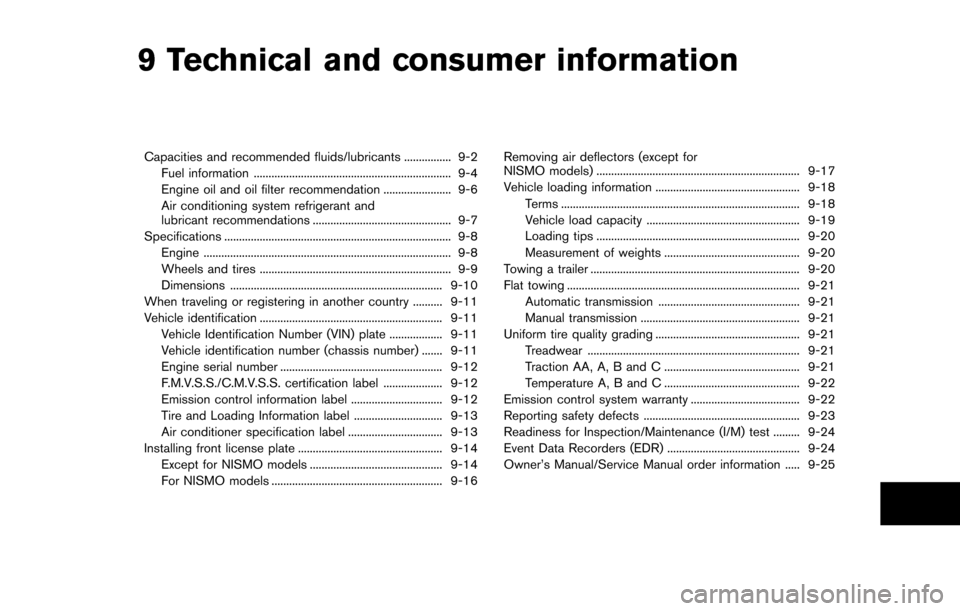
9 Technical and consumer information
Capacities and recommended fluids/lubricants ................ 9-2Fuel information ................................................................... 9-4
Engine oil and oil filter recommendation ....................... 9-6
Air conditioning system refrigerant and
lubricant recommendations ............................................... 9-7
Specifications ........................................................................\
..... 9-8
Engine ........................................................................\
............ 9-8
Wheels and tires ................................................................. 9-9
Dimensions ........................................................................\
9-10
When traveling or registering in another country .......... 9-11
Vehicle identification .............................................................. 9-11 Vehicle Identification Number (VIN) plate .................. 9-11
Vehicle identification number (chassis number) ....... 9-11
Engine serial number ....................................................... 9-12
F.M.V.S.S./C.M.V.S.S. certification label .................... 9-12
Emission control information label ............................... 9-12
Tire and Loading Information label .............................. 9-13
Air conditioner specification label ................................ 9-13
Installing front license plate ................................................. 9-14 Except for NISMO models ............................................. 9-14
For NISMO models .......................................................... 9-16 Removing air deflectors (except for
NISMO models) ..................................................................... 9-17
Vehicle loading information ................................................. 9-18
Terms ........................................................................\
......... 9-18
Vehicle load capacity .................................................... 9-19
Loading tips ..................................................................... 9-20
Measurement of weights .............................................. 9-20
Towing a trailer ....................................................................... 9-20
Flat towing ........................................................................\
....... 9-21 Automatic transmission ................................................ 9-21
Manual transmission ...................................................... 9-21
Uniform tire quality grading ................................................. 9-21 Treadwear ........................................................................\
9-21
Traction AA, A, B and C .............................................. 9-21
Temperature A, B and C .............................................. 9-22
Emission control system warranty ..................................... 9-22
Reporting safety defects ..................................................... 9-23
Readiness for Inspection/Maintenance (I/M) test ......... 9-24
Event Data Recorders (EDR) ............................................. 9-24
Owner’s Manual/Service Manual order information ..... 9-25
Page 394 of 428

Capacity (Approximate)Recommended specifications
US measure Imp measure Liter
Brake fluid Refill to the proper oil level according to the
instructions in the “8. Maintenance and do-it-
yourself” section.Except for NISMO models:
.
Genuine NISSAN Super Heavy Duty Brake Fluid* or equivalent DOT3
*: Available in mainland USA through a NISSAN dealer.
For NISMO models:
. Genuine NISSAN Brake Fluid R35 Special ll *1 *2
*1: Never mix different types of fluids.
*2: Genuine NISSAN Brake Fluid R35 Special II is the factory fill brake fluid. The
Vehicle Dynamic Control (VDC) unit and other related parts were specially designed
for this brake fluid. Using any other fluid may result in improper operation of the brake
system which could result in serious injury or death.
Clutch fluid .
Genuine NISSAN Brake Fluid R35 Special II*1,*2 or equivalent DOT4
*1: Never mix different types of fluids.
*2: NISSAN recommends Genuine NISSAN Brake Fluid R35 Special II available at a
NISSAN dealer.
Multi-purpose grease ———.
NLGI No. 2 (Lithium soap base)
Air conditioning system refrigerant ———.
HFC-134a (R-134a)
. For additional information, see “Vehicle identification” (P.9-11) for air conditioner
specification label.
Air conditioning system lubricants ———.
NISSAN UV Luminous Oil Type S or exact equivalent
Window washer fluid 4-3/444.5.
Genuine NISSAN Windshield Washer Concentrate Cleaner & Antifreeze or
equivalent
Technical and consumer information9-3
Page 398 of 428
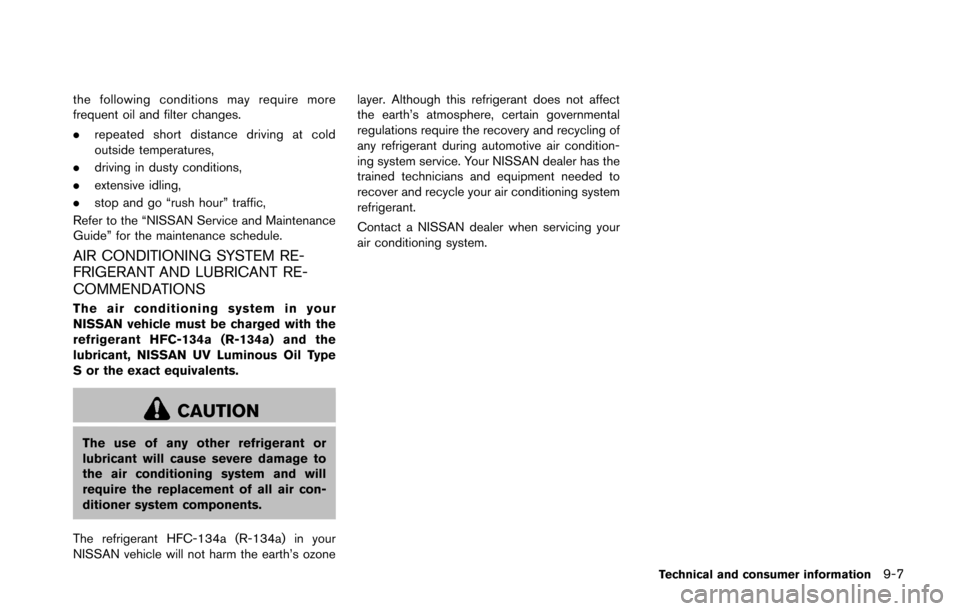
the following conditions may require more
frequent oil and filter changes.
.repeated short distance driving at cold
outside temperatures,
. driving in dusty conditions,
. extensive idling,
. stop and go “rush hour” traffic,
Refer to the “NISSAN Service and Maintenance
Guide” for the maintenance schedule.
AIR CONDITIONING SYSTEM RE-
FRIGERANT AND LUBRICANT RE-
COMMENDATIONS
The air conditioning system in your
NISSAN vehicle must be charged with the
refrigerant HFC-134a (R-134a) and the
lubricant, NISSAN UV Luminous Oil Type
S or the exact equivalents.
CAUTION
The use of any other refrigerant or
lubricant will cause severe damage to
the air conditioning system and will
require the replacement of all air con-
ditioner system components.
The refrigerant HFC-134a (R-134a) in your
NISSAN vehicle will not harm the earth’s ozone layer. Although this refrigerant does not affect
the earth’s atmosphere, certain governmental
regulations require the recovery and recycling of
any refrigerant during automotive air condition-
ing system service. Your NISSAN dealer has the
trained technicians and equipment needed to
recover and recycle your air conditioning system
refrigerant.
Contact a NISSAN dealer when servicing your
air conditioning system.
Technical and consumer information9-7
Page 404 of 428
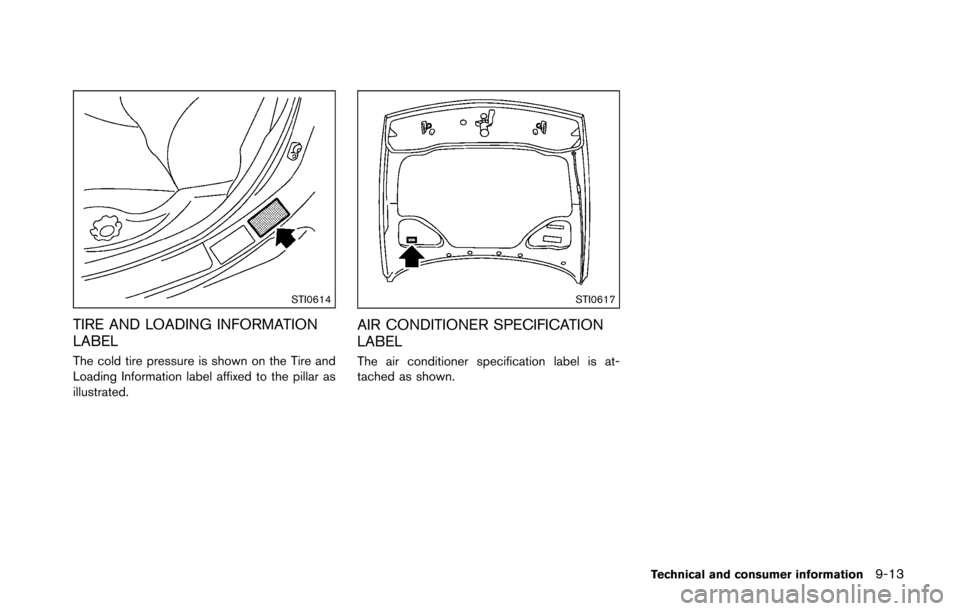
STI0614
TIRE AND LOADING INFORMATION
LABEL
The cold tire pressure is shown on the Tire and
Loading Information label affixed to the pillar as
illustrated.
STI0617
AIR CONDITIONER SPECIFICATION
LABEL
The air conditioner specification label is at-
tached as shown.
Technical and consumer information9-13